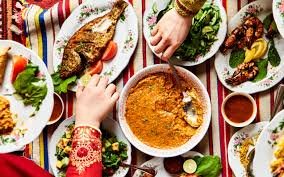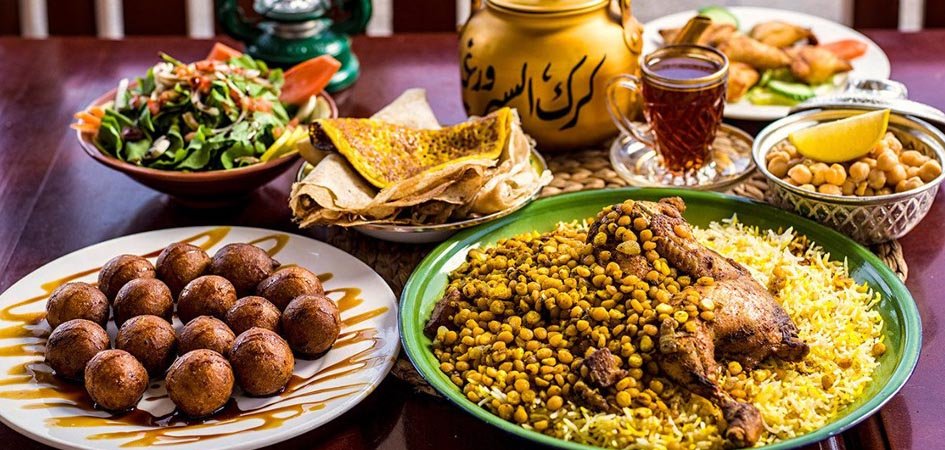In the bustling heart of the UAE, where glass towers rise high and luxury brands light up the streets, it’s easy to forget that just decades ago, life here was rooted in the sands, seas, and survival. But walk into an Emirati Cuisine—rich with the scent of cardamom, slow-cooked meats, and fragrant rice—and you’re transported into a world where food was memory, history, and identity on a plate.
Emirati cuisine is not just about what’s eaten. It’s about why and how—and through it, the UAE’s past is served with every dish.
A Taste of Geography: The Foundations of Emirati Food
Before skyscrapers and shopping malls, the people of the Emirates were primarily Bedouins, fishermen, pearl divers, and traders. The harsh desert, arid mountains, and surrounding seas shaped what could be eaten—and when.

- In the coastal areas, fish was a staple, dried and salted to last.
- In desert communities, dates, camel milk, and grains formed the core diet.
- From trading routes, came spices like saffron, cinnamon, turmeric, and dried lime—ingredients that remain essential today.
The result is a cuisine that is resourceful, layered, and deeply connected to the land.
Dates and Coffee: A Symbol of Hospitality
Any journey into Emirati culinary culture begins with two iconic staples: dates and Arabic coffee (qahwa).
Dates have been grown in the region for over 7,000 years. Sweet, nourishing, and long-lasting, they were crucial for survival in the desert. Today, dates are a symbol of hospitality, often the first thing offered to guests.
Arabic coffee, infused with *cardamom and sometimes saffron, is served in tiny cups, refilled as a sign of respect. It’s not just a beverage—it’s part of a ritual that reflects *the Emirati values of generosity, warmth, and welcome.

Main Dishes that Tell a Story
Behind every traditional Emirati meal lies a tale of trade, travel, and tradition.
1. Al Harees
A humble dish of *wheat and meat, cooked slowly in clay pots for hours until it reaches a porridge-like consistency. Al Harees speaks to **simplicity and patience, often prepared during *Ramadan and Eid—times of reflection and family.
It tells the story of a people who valued sustenance over luxury, where food was not wasted, and cooking was a communal act.
2. Al Majboos / Machboos
Rice spiced with *loomi (dried lime), turmeric, cardamom, and cooked with lamb, chicken, or fish. This dish reflects *influences from India and the Persian Gulf, introduced through maritime trade.
Machboos is a fragrant memory of the sea, where sailors brought back not just spices, but new ideas and flavors, which the Emirati people made their own.
3. Madrouba
A dish where chicken or fish is mashed into spiced rice and lentils until it becomes thick and hearty. Madrouba showcases the creative use of basic ingredients, turning scarcity into comfort food.
It reflects how families stretched their resources, adding love and labor in every stirring spoon.
4. Balaleet
A surprising breakfast or dessert dish—sweet vermicelli noodles flavored with cardamom and saffron, topped with an omelet. Sweet and savory collide, just as tradition and adaptation do in Emirati culture.

Bread, the Backbone of Every Meal
Bread in the UAE isn’t just a side dish—it’s a part of everyday life. Regag, a thin, crepe-like bread, is made on a hot plate and often served with cheese, honey, or fish sauce.
Another favorite is *Khameer, a slightly sweet, thick bread spiced with dates or aniseed. These breads were often *cooked over firewood or on hot stones, a technique passed down from Bedouin ancestors who baked in the open desert.
To tear, dip, and share bread is to participate in a tradition that’s as old as the dunes.
The Influence of Trade and Migration
Emirati cuisine is *not static—it has evolved over centuries thanks to the UAE’s role as a **crossroads of trade. Long before the skyscrapers, merchants from *India, Persia, East Africa, and the Levant were docking at the Gulf’s shores.
These exchanges introduced:
- Spices from India
- Rice from Persia
- Grilling techniques and herbs from the Levant
- Coconut and tamarind flavors from East Africa
Instead of resisting foreign influences, Emirati cuisine embraced and absorbed them—just as the culture did.
This adaptability is a reflection of the Emirati spirit itself: open, resilient, and unafraid of change.
Food as a Celebration
In the UAE, food is often central to major life events.
- Weddings feature grand servings of rice and meat, shared from large platters to symbolize unity and abundance.
- During *Ramadan, communal Iftar meals are prepared with care and tradition—breaking the fast with *dates and laban (buttermilk) before the meal.
- At *Eid, dishes like Harees and sweets like *luqaimat (deep-fried dough balls with date syrup) are lovingly made and shared.
Every dish, every flavor, is an act of remembrance and celebration.
The Modern Revival
In recent years, there’s been a revival of interest in *traditional Emirati cuisine, especially among younger generations. Across Abu Dhabi, Dubai, and Sharjah, modern cafes and fine-dining restaurants are *reinterpreting classic dishes.
- Think Machboos risotto or luqaimat with saffron caramel glaze.
- Food festivals and cooking shows now feature Emirati chefs reclaiming and reinventing their heritage.
- Initiatives are underway to document old recipes, preserve cooking techniques, and teach the next generation of home cooks and professionals.
This culinary revival is more than a trend—it’s a cultural reclamation, reminding people that in a rapidly changing world, tradition still has a seat at the table.
Final Thoughts: A Heritage Served Hot
Emirati cuisine is not about excess or extravagance. It’s about memory, resilience, and identity. It tells the story of a nation that thrived on little but gave with much, where hospitality wasn’t just a habit but a way of life.
Today, when you dip a warm regag into a bowl of date syrup or inhale the spices rising from a pot of machboos, you’re not just eating—you’re tasting history.
And in a country that has transformed in one generation from sand to skyline, that’s the true power of food: to keep us grounded, connected, and whole.
Do follow UAE Stories on Instagram.
The Evolution of Emirate Art: From Traditional Crafts to Contemporary Masterpieces













